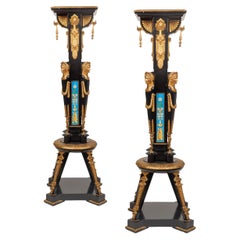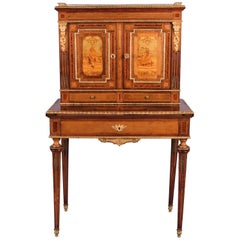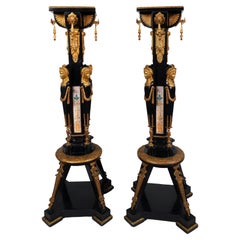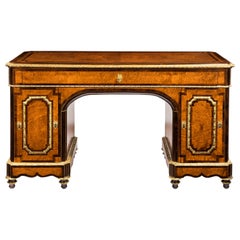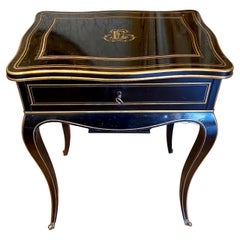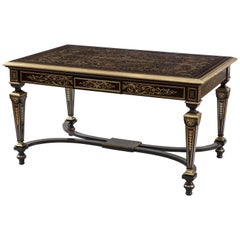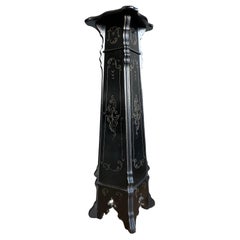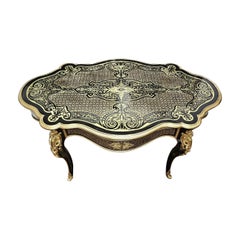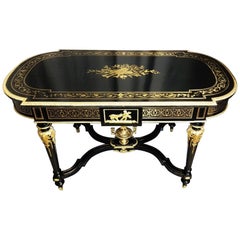Charles-Guillaume Diehl Tables
Charles-Guillaume Diehl founded his cabinet making and decoration firm at 19 Rue Michel-Le-Comte in 1885. His workshops produced elegant little pieces of furniture in rosewood and thuja and novelties with bronze and porcelain embellishments. It was his luxury boxes, however, (liqueur cellarettes, cigar cabinets, games boxes, cashmere cases, jewelry cases) which assured Diehl’s renown. Already rewarded with a bronze medal at the Universal Exhibition of 1855 in Paris, he exhibited a jardinière with china columns and a liqueur cabinet at the Industrial Arts Exhibition in 1861. In collaboration with the designer Jean Brandely (active from 1867 until 1873), Diehl renovated his decorative repertory and created astonishing pieces of furniture in the Grecian style, which had a dazzling success at the Universal Exhibition in Paris in 1867, where his cabinets also won a silver medal. Certain motifs were so typical of Diehl’s work that they received extensive commentary by the art critic J. Mesnard in his book “Les Merveilles de l’Exposition Universal de 1867”. He writes of a table of which “the pendant bearing hooks and the fan-shaped radiating motif which ornaments the entablature are engraved with love” and a jewelry case where “The head in fine Grecian style makes up the essential part of the fine gilt bronze ornamentation”. For this Universal Exhibition, Diehl also formed a partnership with two famous sculptors: Emile Guillemin (1841–1907), who carved the relief for a mahogany sideboard with galvanic gilt bronzes and Emmanuel Frémiet (1824–1910), who executed the low relief for a cedar medal cabinet with marquetry and silver-plated bronzes. Diehl was again rewarded with a medal of honor at the Union Central Exhibition of 1869 and a progress medal at the Universal Exhibition in Vienna in 1873. Showered with praise by the critics, Diehl is considered one of the most innovative artists of the 19th century. His final appearance was at the 1878 Universal Exhibition in Paris, where he presented outside the competition, his most recent creations, including a work table in marquetry, which with its naturalistic grasshopper motif anticipated Art Nouveau.
Late 19th Century French Napoleon III Antique Charles-Guillaume Diehl Tables
Ormolu
19th Century French Louis XV Antique Charles-Guillaume Diehl Tables
Ormolu
1860s French Greek Revival Antique Charles-Guillaume Diehl Tables
Bronze
1860s French Napoleon III Antique Charles-Guillaume Diehl Tables
Amboyna
19th Century French Napoleon III Antique Charles-Guillaume Diehl Tables
Bronze
19th Century French Louis XVI Antique Charles-Guillaume Diehl Tables
Brass
Early 20th Century European Arts and Crafts Charles-Guillaume Diehl Tables
Wood, Beech, Paint
Early 2000s Chinese Qing Charles-Guillaume Diehl Tables
Teak
1980s Italian Post-Modern Vintage Charles-Guillaume Diehl Tables
Travertine
Early 19th Century French Neoclassical Antique Charles-Guillaume Diehl Tables
Pine
Early 20th Century European Victorian Charles-Guillaume Diehl Tables
Mahogany, Mirror, Wood
Mid-19th Century French Empire Antique Charles-Guillaume Diehl Tables
Marble
Late 19th Century British Antique Charles-Guillaume Diehl Tables
Softwood, Mahogany
Mid-19th Century French Antique Charles-Guillaume Diehl Tables
Wood
Late 19th Century American Aesthetic Movement Antique Charles-Guillaume Diehl Tables
Birdseye Maple
Late 19th Century French Louis XV Antique Charles-Guillaume Diehl Tables
Kingwood
2010s Brazilian International Style Charles-Guillaume Diehl Tables
Wood
19th Century French Gothic Revival Antique Charles-Guillaume Diehl Tables
Gold Leaf
1860s French Napoleon III Antique Charles-Guillaume Diehl Tables
Brass, Bronze
1860s French Napoleon III Antique Charles-Guillaume Diehl Tables
Brass, Bronze
1870s French Art Nouveau Antique Charles-Guillaume Diehl Tables
Copper
